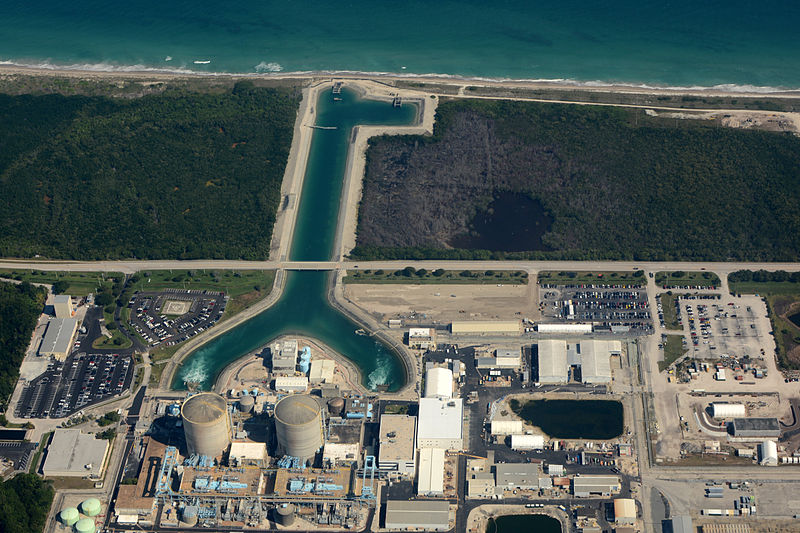A new facility being built at the Advanced Photon Source will allow research into irradiated materials.
This rendering shows the Activated Materials Laboratory (AML), to be constructed as part of the Advanced Photon Source upgrade that includes the High-Energy X-ray Microscope (HEXM) and the In Situ Nanoprobe (ISN). This new facility will simplify the process of researching nuclear materials.
(Image: Argonne National Laboratory)
The lack of a specialized laboratory at Argonne National Laboratory’s Advanced Photon Source (APS) has slowed efforts to study irradiated materials at the facility. Things will change soon, however, with the addition of the new Activated Materials Laboratory that is planned to be built and operational by 2024.
Nine Mile Point (Photo: Constellation Energy)
Exelon Generation has received a grant from the Department of Energy to explore the potential benefits of on-site hydrogen production and has chosen its Nine Mile Point nuclear power plant as the demonstration site, the company announced on Wednesday. (In 2019, Exelon received a conditional commitment from the DOE to co-fund a hydrogen electrolyzer demonstration at a nuclear plant.) Located in Scriba, N.Y., Nine Mile Point consists of two boiling water reactors—the 620-MWe Unit 1 and the 1,287-MWe Unit 2.
The EBR-II sodium fast reactor at Idaho National Laboratory began operations in 1964 and generated electricity for decades. Soon it will serve as a National Reactor Innovation Center test bed for future advanced reactor demonstrations. (Source: ANL)
At the box office or streaming at home, it’s fear, not truth, that sells. The laws of physics are swept aside, apocalypse is inevitable, and superpowered heroes wait until the last possible second to save the universe. It can make for great entertainment, but in the real world we need to stick with science over science fiction and be wowed by engineering, not special effects.
The truth is, science and innovation are incredible in their own right. From communications and machine learning to space travel and medical advances, technology is evolving in hyperdrive to solve real problems. With climate change and global warming here on earth, we don’t have to go looking for trouble in a galaxy far, far away.
A still image from a three-part video tour of NuScale’s facilities. (Photos: NuScale Power)
NuScale Power has signed a memorandum of understanding with Xcel Energy to explore the feasibility of the utility’s serving as a plant operator at NuScale plants, the Portland, Ore.-based small modular reactor developer announced earlier this week.
Xcel owns and, through subsidiary Northern States Power Company, operates Minnesota’s two nuclear plants, Monticello and Prairie Island. The Monticello facility houses one 671-MWe boiling water reactor, while Prairie Island has twin 550-MWe pressurized water reactors.
A color-enhanced photograph of the NIF target bay. (Photo: LLNL/Damien Jemison)
Lawrence Livermore National Laboratory is celebrating the yield from an experiment at the National Ignition Facility (NIF) of more than 1.3 megajoules of energy—eight times more than the yield from experiments conducted this spring and 25 times more than NIF’s 2018 record yield.
The magnet system of Wendelstein 7-X features 50 superconducting magnet coils. (Graphic: IPP)
The Max Planck Institute for Plasma Physics (IPP) was founded in Garching, Germany, in 1960, the same year that its Wendelstein 1a stellarator began operation. Wendelstein 7-X is now operating at IPP’s site in Greifswald, Germany, and one of the objectives the device was designed to achieve has recently been confirmed, IPP announced on August 12. Analysis by IPP scientists shows that the twisted magnetic coils of the device successfully control plasma energy losses, indicating that stellarator fusion devices could be suitable for power plants, according to a detailed analysis of experimental results published on August 11 in Nature.
St. Lucie nuclear power plant. (Photo: D Ramey Logan)
Florida Power and Light Company, a subsidiary of NextEra Energy, has filed a subsequent license renewal application with the Nuclear Regulatory Commission for the two-unit St. Lucie nuclear power plant, seeking a second 20-year renewal of the reactors’ operating licenses.
The 67th president of the American Nuclear Society looks to expand the Society’s outreach across the nuclear spectrum.
If there’s one thing Steven Nesbit enjoys in life, it’s the challenge brought on by change. Whether that means growing up as a self-described “Marine brat” and moving five times before junior high school or transitioning in his professional career from the engineering side of the nuclear industry to the spent fuel and policy-driven side, Nesbit welcomes change. “I don’t mind turning the crank for a while, but I like to learn new things, and the best way to do that is to do new things.”
Hope Creek nuclear power station.
In the latest step toward its recently stated goal of achieving net-zero carbon emissions by 2030, Newark, N.J.–based Public Service Enterprise Group, owner of the Hope Creek and Salem nuclear plants, has entered into an agreement to sell its 6,750-MW fossil generating portfolio to newly formed subsidiaries of ArcLight Energy Partners Fund VII—a fund controlled by ArcLight Capital Partners. (ArcLight Capital is a Boston-based private equity firm, founded in 2001 and focused on energy infrastructure investments.) The $1.92 billion deal, announced by PSEG on August 12, is expected to be completed late in the fourth quarter of 2021 or the first quarter of 2022.
Kinzinger (left) and Doyle (right).
Last week, Reps. Adam Kinzinger (R., Ill.) and Mike Doyle (D., Pa.) introduced legislation that would establish a financial credit program for economically challenged nuclear power plants and would authorize funding for “nuclear closure communities.”
The Preserving Existing Nuclear Energy Generation Act (H.R. 4960) is the House companion to certain provisions in a Senate proposal that was reported favorably by the Senate Energy and Natural Resources Committee on July 14 and was subsequently included in the Infrastructure Investment and Jobs Act, the $1.2 trillion bipartisan package that the Senate passed earlier this week via a 69–30 vote.







 The Canadian Nuclear Safety Commission and the U.S. Nuclear Regulatory Commission have completed the first collaborative project under a two-year-old memorandum of cooperation (MOC) aimed at enhancing technical reviews of advanced reactor and small modular reactor technologies, the CNSC announced earlier this week.
The Canadian Nuclear Safety Commission and the U.S. Nuclear Regulatory Commission have completed the first collaborative project under a two-year-old memorandum of cooperation (MOC) aimed at enhancing technical reviews of advanced reactor and small modular reactor technologies, the CNSC announced earlier this week.












